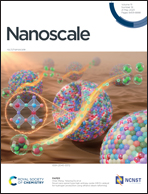Development of nanoparticle bulk morphology analysis: a multidomain XRD approach†
Abstract
The appearance of twin/stacking faults in nanoparticles creates strains affecting the catalytic, optical, and electrical properties of nanomaterials. Currently, there is a lack of experimental tools for a numeric characterization of these defects in samples. Therefore, many structure–property correlations are poorly understood. Here, we report the exploration of the twinning effect on the XRD pattern and its practical application. We developed a new approach focused on the special mutual orientation of periodic fcc segments, domains. Using computational simulations, we found that the more domains, the smaller the height ratio of 220 to 111 diffraction peaks. Knowing this correlation, we performed the XRD bulk morphology and size analysis of Au and AuPt samples. The obtained results were compared with the results of TEM and SAXS analyses. In a broader context, our multidomain XRD method is a simple alternative to TEM which enables unraveling the structure–property correlations in NP studies.



 Please wait while we load your content...
Please wait while we load your content...